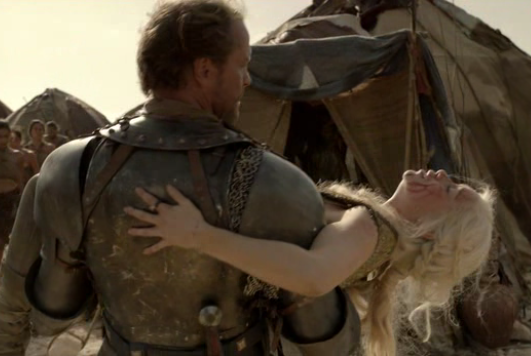While
the idea of a lump child has not (in my experience) been extensively dealt with
in modern media, that is not to say that The
King of Tars hasn’t made any “appearance” in recent years. In fact, an
interesting parallel can be drawn between this middle English narrative and
certain occurrences in the extremely popular novel/television series Game of Thrones. Specifically, it is the
interactions between Daenerys and Khal Drogo (as well as the general narrative
surrounding these individuals) that I would draw your attention to. This arc
portrays a sort of perversion of the original story, though retaining many of
the key elements.
 The
first thing to consider is the marriage itself. In both cases, the audience is
presented with a foreign/pagan king who seeks out a white/Christian princess to
be his bride based upon her beauty. However, in The King of Tars the King only offers his daughter away after his
people and lands are threatened with violence by Sultan Laban, whereas in Game of Thrones it is Viserys
(essentially the King of Tars in this situation) who bargains away his sister
(the princess) to Drogo to gain the Khal’s troops and support for his plans to
retake Westeros. This situation presents the first example of the switching of
roles in this modern interpretation of the piece, with the role of aggressor
being moved from the Dothraki (Saracens) to the Targaryens (Christians).
The
first thing to consider is the marriage itself. In both cases, the audience is
presented with a foreign/pagan king who seeks out a white/Christian princess to
be his bride based upon her beauty. However, in The King of Tars the King only offers his daughter away after his
people and lands are threatened with violence by Sultan Laban, whereas in Game of Thrones it is Viserys
(essentially the King of Tars in this situation) who bargains away his sister
(the princess) to Drogo to gain the Khal’s troops and support for his plans to
retake Westeros. This situation presents the first example of the switching of
roles in this modern interpretation of the piece, with the role of aggressor
being moved from the Dothraki (Saracens) to the Targaryens (Christians).
There is
also the matter of “conversion” to consider. Unlike the princess in K.o.T., Daenerys seems much more truly
willing to adopt the culture and practices of her new people. The Targaryen
princess adapts to the Dothraki style of clothing, and in time and with practice
becomes versed in the language. This once again presents a parallel between the
two works, as the princess does much the same in the K.o.T. (while language is not specifically mentioned in the middle
English text, I feel it is safe to assume based on the context that the
princess would have likely had to adapt her speaking at least in some way when transferred
from a European/Christian world to that of the Saracens). However, the two
differ in their adoption of the cultures religion. While Daenerys seems willing
to learn and to a degree embrace the Dothraki faith, the princess only pretends
to convert and states that she really held Christ in her heart the whole time.
This change will play an interesting role in the conclusions of these pieces.
 Then, of
course, there is the matter of the child itself. In both cases, the audience is
presented with a “monster” child, with the princess giving birth to a lump and
Daenerys giving birth to a scaled, blind, batwinged creature filled with grave
worms. In both cases, these malformations can be linked to a “break of faith”
of sorts. However, while Sultan Laban is the apparent cause of this misfortune
in K.o.T., due to his non-Christian
faith, in G.o.T. it is Daenerys who
leads to the malformed child. The Targaryen girl, in a bid to save her husband’s
life, consorted with “dark magic” which twisted and consumed the infant. While
these magics do not originate in Daenerys faith, she still is the one who seeks
out the practitioner capable of their use, thus taking on the role of the “heretic”
in that narrative. However, potentially one could consider the burning of Khal
Drogo and the birth of the dragons following the sacrifice of the child to be
the equivalent of the baptism in K.o.T.,
with the previously monstrous child/failed resurrection only being righted
after undergoing this ritual.
Then, of
course, there is the matter of the child itself. In both cases, the audience is
presented with a “monster” child, with the princess giving birth to a lump and
Daenerys giving birth to a scaled, blind, batwinged creature filled with grave
worms. In both cases, these malformations can be linked to a “break of faith”
of sorts. However, while Sultan Laban is the apparent cause of this misfortune
in K.o.T., due to his non-Christian
faith, in G.o.T. it is Daenerys who
leads to the malformed child. The Targaryen girl, in a bid to save her husband’s
life, consorted with “dark magic” which twisted and consumed the infant. While
these magics do not originate in Daenerys faith, she still is the one who seeks
out the practitioner capable of their use, thus taking on the role of the “heretic”
in that narrative. However, potentially one could consider the burning of Khal
Drogo and the birth of the dragons following the sacrifice of the child to be
the equivalent of the baptism in K.o.T.,
with the previously monstrous child/failed resurrection only being righted
after undergoing this ritual.
I find
it interesting that in what could be considered a modern take on this middle English
romance it is the Christians (Targaryens) who conform to the medieval negative
ideals often associated with the Saracens. This change is likely an attempt to
avoid the racism and Christian-superiority evident in the original text,
although more research would be required to flesh out and verify/validate this
theory.
No comments:
Post a Comment